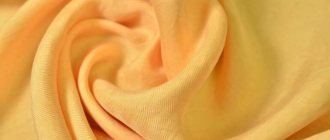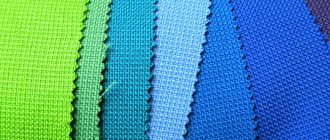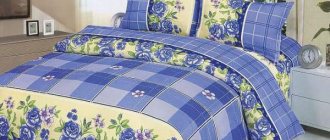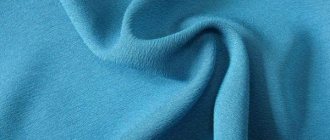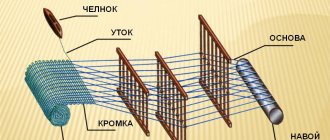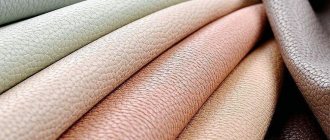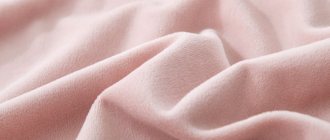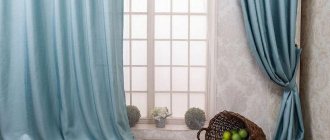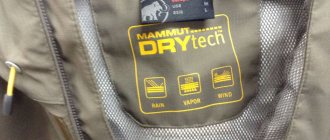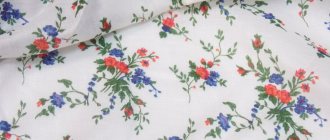What is polyester
Polyester is a fabric that is 100 percent synthetic. The material is obtained from polystyrene, an oil refining product, passed under high pressure through small diameter holes.
Next, the threads are stretched to the required diameter, dyed, and intertwined in different ways. Polyester fiber was first produced in 1949.
Polyester is a synthetic material, but the material is rarely used in its pure form. During the production process, other components are often added - viscose, cotton, wool. This changes the properties of the fabric, making it softer, more breathable, and more pleasant to handle. The composition of each item is indicated on the label.
Externally, the material is similar to wool, but its characteristics resemble cotton material. High-quality fabric does not stain the skin when worn, has no odor, and does not fade when washed.
Types of fabric
The production of polyester-based fabrics is varied. Types of material:
- Micro-oil - made from spandex (polyester fibers) and viscose in a ratio of 7 to 3. The result is a light, soft material that does not wrinkle. Externally similar to silk. Skirts and blouses are made from this material.
- Oil - consists of viscose and a small amount of polyester fibers. Another name is knitwear. Sweatshirts, trousers and dresses are made from dense, warm material.
- Stretch - contains from 5 to 15% elastane or from 85 to 95% polyester. It stretches, returning to its previous shape. Swimwear, underwear, and tracksuits are made from it.
- Cotton, or polycotton, is a combination of synthetic and cotton threads. Makes the fabric soft, pleasant to the touch, breathable. The material is used to make bed and underwear.
- Holofiber is fluffy and retains heat well. Used for filling pillows, blankets, clothes.
- Mesh is a dense fabric that does not change shape. It is inserted into windows to protect against insects. Comes in different colors and thickness.
- Recycled polyester - created from recycled plastic products. This is a form of combating environmental pollution, as well as a way to obtain cheap material. The fabric is non-degradable. Tracksuits are often made from it. Things made of plastic are also produced by well-known world-famous companies.
Based on density and strength, they are distinguished:
- 300d – waterproof, material for sports equipment;
- 500d – make tents, backpacks, covers for covering cars;
- polyester 600d – durable, used in the manufacture of equipment for climbers;
- 900d - used for protection against ultraviolet radiation and water in extreme conditions.
Properties of polyester
If in the last century items made from natural raw materials predominated in the wardrobe of the population, now most consumers prefer synthetic products. Thanks to the introduction of new technologies into production, synthetic fabrics have excellent consumer properties that attract buyers.
pros
Polyester is a wear-resistant, inexpensive, lightweight material that retains its color and shape for a long time, does not require ironing, and does not deteriorate under the influence of acids. The fabric is easy to cut and sew. The material is not susceptible to damage by insects, does not smell or absorb odors, and has excellent elasticity: it stretches easily without losing its shape.
Polyester fiber has the ability to repel moisture from the surface, so clothes made from it do not get wet. This feature contributes to the fact that polyester fabric is used for sewing workwear, jackets and quilted coats.
One of the remarkable qualities of matter is its resistance to pellet formation. Even after numerous washes, your clothes will look like new. Products made from polyester dry quickly after washing, which is also an undoubted advantage of the material.
The fabric does not fade at all and does not leave staining marks on the skin or other clothes.
Minuses
Among these positive properties of the material, there are tangible negative qualities. One of them is the air tightness and rigidity of the 100% polyester fabric. Therefore, it is not suitable for sewing summer and children's clothing. The inability to allow air to pass through can have a negative impact on how you wear things. Sensitive people may experience skin irritation, and children may experience heat rash.
To increase breathability and softness, polyester fiber is mixed with cotton, wool, viscose, and linen. By mixing synthetic and cotton fibers, breathable, pleasant to the touch, wear-resistant fabrics are obtained.
Another disadvantage of polyester is electrostaticity. To prevent clothes from sticking, they are treated with special means.
In general, polyester can withstand frequent washing and retain its original appearance, but it does not tolerate high temperatures well, so when caring for polyester products, special attention is paid to washing and ironing.
Advantages and disadvantages of the material
Positive qualities of the fabric:
- With proper care, things do not stretch. Adding wool or viscose makes the product more elastic, and after the cessation of exposure it returns to its original form.
- It is highly waterproof, and, thanks to the weaving of other types of threads, air passes through it - modern polyester breathes.
- Due to the density of the threads, things are resistant to stains. Wash well in warm and cool water, dry quickly.
- It's warm in such clothes. It protects from the wind.
- Doesn't roll down. Constant use and frequent washing do not affect the smoothness of the surface.
- When dried properly, it practically does not wrinkle. Easy to smooth out.
- By dyeing you can get any color. The fabrics do not fade.
- They don't eat insects. Things can be stored without fear of moths.
- Affordable.
In what weather is it convenient to wear polyester:
- windy;
- raw;
- cold.
In the summer, things that are specifically designed for this purpose are suitable for wearing - swimsuits, swimming trunks.
Cons of polyester:
- At temperatures above 40 °C, the threads begin to break down. Boiling quickly renders the item unusable.
- Friction and twists lead to deformation of the material. Hand washing and spinning are carried out in a gentle mode.
- Failure to comply with the temperature conditions when washing or ironing leads to the fact that the products lose their shape.
- Electrified. To remove static electricity, use an antistatic agent or conditioner.
- The original material is hard, the fabric is softened by the addition of fibers. The more polyester a product contains, the higher the likelihood of chafing the skin.
- Poor quality material can be harmful - cause allergies, cause excessive sweating. Not suitable for wearing in hot weather due to its density - polyester is hot in the summer.
- The material is a fire hazard - it ignites easily.
Watch the TED talk:
Pros and cons of fabric
Advantages of the fabric:
- durable and wear-resistant;
- with proper care it does not deform for a long time and retains the brightness of colors;
- easy to care for;
- retains heat well and does not get wet;
- not affected by acids and solvents;
- dries quickly;
- resistant to dirt and pellets;
- has a low cost.
Disadvantages of polyester:
- becomes electrified, attracts dust, sticks to the body and other tissues;
- poorly breathable, not suitable for hot weather;
- complex stains are difficult to remove from its surface;
- highly flammable;
- pure polyester is quite hard and can rub the skin when worn.
Comparison with other materials
In addition to polyester, other synthetic materials are also produced. What is the difference between polyamide fabric and polyester:
- different starting chemicals;
- allows water to pass through;
- easily torn, damaged when stretched.
Pantyhose, stockings, fishing nets, and ropes are made from polyamide.
Comparison of nylon and polyester:
- differ in chemical composition;
- both are light, durable, cheap;
- nylon shines, is poorly breathable, and is exposed to UV rays.
Elastane and polyester: the difference
Decoration option
Polyester fibers became the basis for polyester; it is a completely synthetic formation. Included in most modern fabrics. In appearance and tactile sensations, the material is very similar to wool. A durable and wear-resistant type of material that retains its original parameters for a long time under any conditions.
Polyester is similar to cotton, which many see as an advantage. There are other positive qualities:
- Easy to wash, even with cold water. Lycra has other positive properties.
- No maintenance requirements. This is where the difference lies too.
- The base does not wrinkle. Including - if the composition is indicated as 95 polyester, 5 elastane, what kind of fabric it is - the packaging helps to understand.
Elastane is a very thin fabric characterized by elasticity. Capable of freely passing air. Refers to tight-fitting materials. Things with such a base do not lose their shape for a long time, even with numerous washes. The main thing is to use the delicate mode and monitor the temperature so that it does not exceed 40 degrees. Next we will look at how to choose polyamide or elastane, which is better.
You might be interested in what is remarkable about Rayon fabric: what it is made of and where it is used
Areas of application of polyester
The combination of positive properties makes the fabric in demand in many areas. Polyester is a fabric for sewing curtains of any density, length, width and with a variety of patterns. With their help you can change the interior:
- make the kitchen more spacious by using fabrics in light shades;
- prevent water droplets from splashing in the bathroom;
- decorate an outdoor gazebo, protecting its space from the wind.
Bed linen wears out less, retains bright colors for a long time, but becomes electrified. Clothes made of polyester come in a variety of shapes and colors; it is easy to make arrows and curly creases on them using an iron.
Other uses of polyester:
- diapers;
- bed sheets;
- outerwear - jackets, down jackets;
- underwear;
- ship linens;
- workwear;
- tents.
Synthetic fibers are used as filler for mattresses, insulation for winter jackets, down jackets, coats and shoes.
Description of polyviscose
A dress made from Pliviscose fabrics
is a modern analogue for natural fabrics. Including such as silk and cotton, linen. Two main components - polyester and viscose - give it its name. The material is surprisingly soft to the touch.
Composition, production features
Synthetic clothing
Polyviscose is a mixed type of material. The two main components are as follows:
- 100% synthetic polyester.
- Viscose of artificial origin. Polyester is often added to it.
Note. The composition usually contains the most synthetics, up to 60-70%. Strength and wear resistance are ensured precisely due to this component. Softness and airtightness appear when wood cellulose is used as a base.
But in some compositions viscose takes up 70%, and polyester – 30%.
By adding elastane, the fabric will have better stretch. Strength will also increase. For sewing casual clothes, such combinations are the best option.
In polyviscose fabrics, various weaves of threads are used:
- Twill.
- Satin.
- Transverse.
Surface – matte or shiny. From it you can also understand whether lavsan and polyester are the same thing or not.
Application
Synthetic knitwear
Polyviscose fibers become the basis for the following products:
- Carpets.
- Coat.
- Jackets.
- Dresses.
- Pants for men and women.
- Jackets.
- Blouses.
- Skirts.
- School children's uniform.
The lining of outerwear can also be polyviscose. Thanks to this, things stop stretching and retain their shape for a long time.
Important. The material produces high-quality curtains that do not require special care requirements. They are easy to wash, dry cleaning is acceptable. The main thing is that the products retain their attractive appearance for a long time.
Rules of care
Warm clothes
If you follow the rules, the product will last longer.
- Wash.
We accept both the manual version and the use of appropriate machines. The main thing is to use water with a temperature of a maximum of 40 degrees. Before washing, turn the product inside out and fasten all zippers, buttons, and buttons. All fittings must be secured.
You might be interested in what microfiber fabric is made of: description of the material in bedding and shoes
Mild detergents work best with polyviscose. It is necessary to ensure that there are no stain removers or chlorine in the composition. Gels do not leave streaks and do the job best.
- Spin. It is recommended for cases with 95% polyester, 5% spandex, what kind of fabric is easy to find out from the manufacturer’s instructions.
This is a delicate mode that helps preserve the original shapes and properties of the material. If we are talking about a washing machine, the number of revolutions should be minimal. When spinning by hand, do not twist the fabric too much.
- Drying.
A vertically hung product is the optimal solution for drying polyviscose-based items. A large number of synthetic fibers does not require the use of dryers. Things are placed on clotheslines.
- Ironing. The main thing is to figure out in advance what kind of fabrics are viscose, elastane.
It is recommended to be especially careful with items containing 30% or more synthetics. It is better to move the iron gently over the fabric with a slightly warm iron. You can use hot air, but then place hot gauze under the product.
Fabric care
Due to the peculiarity of the chemical composition, polyester requires compliance with the rules of care. The fabric should not be exposed to high temperatures, boiled, rubbed vigorously, or twisted when squeezing.
Repairing synthetic clothing has its own characteristics - the edges of the tear are not sewn up, but glued together. The adhesive for fixing the polyester is non-woven fabric. It is applied to a dry fabric surface and ironed on top with a hot iron through gauze.
Removing a tie from a polyester dress is simple - just pull the fabric in different directions, straightening it.
The material washes well, but difficult stains take longer. Here's how to remove paint from polyester clothing:
- Rinse the area of contamination with cold water as soon as possible;
- wipe with a solvent such as “Alcohol White” from the wrong side.
To remove old paint stains, apply turpentine, dishwashing detergent, laundry soap, kerosene, and refined gasoline. You can try scraping off the dirt with a knife blade.
To remove paint from a jacket, you need:
- Spot-treat the stain with warm alcohol. Wash the product.
- Mix 1 tbsp. l. 9% vinegar, dishwashing detergent, 150 g washing powder, 0.5 l of water. Apply to the stain and scrub with an old toothbrush. Wash the item.
You can remove a greasy stain from polyester clothing as follows:
- Rub with laundry soap. Wash off after 30 minutes.
- Apply a thick layer of dishwashing detergent and lather. Wash after 20 minutes.
- Sprinkle with a thick layer of salt and lightly rub it into a cloth with your fingers. Shake off after 10 minutes and wash.
If necessary, you can refresh the item by painting it:
- soak for 30 minutes in water;
- the next day, rinse in water with the addition of ammonia;
- Apply solvent paint strictly according to the instructions (polyester is capricious when it comes to dyeing).
The material can not only be painted, but also bleached. To do this, immerse the stain or yellowed item in a solution of 2 liters of warm water and 2 tbsp. l. hydrogen peroxide with a concentration of 3%. Keep for 20 minutes, then rinse. Do not use chlorine-based bleaches.
Washing and drying
Polyester products can be washed by hand or using an automatic washing machine, following the label. In case 1, do this:
- powder or soap is dissolved in water at a temperature of 35–40 °C;
- soak the item for 30 minutes;
- wash without sudden movements or strong friction;
- dirt is wiped with a rag, a brush is not used;
- rinse in water;
- lightly squeeze.
To get rid of odors, leave things in water for half an hour with the addition of conditioner.
Drying:
- large ones - left to drain on the sides of the bathtub;
- Light items are hung on hangers.
Rules for washing in a washing machine:
- Water temperature is about 40 °C. Number of revolutions – up to 800.
- Modes – “synthetics”, “mixed”, “daily synthetics”, “quick wash”, “colored fabrics”, “delicate fabrics”.
- Clothes are turned inside out. Locks and buttons are fastened.
- Separate loading is desirable - dark products separately from light ones. This will help prevent staining.
To watch the video review:
How to iron material
Polyester items do not require ironing - they straighten when dried. If necessary, large items are ironed at a minimum temperature. This helps prevent damage to the fabric fibers.
How to iron a synthetic jacket:
- set the iron to “synthetic” mode or the lowest temperature;
- moisten gauze with water and squeeze;
- put it on the thing;
- hold the iron with pressure;
- hang on hangers.
Video about washing fabric in a machine:
The nuances of washing polyester items
Some products that contain polyester require a special approach when washing.
How to wash a polyester coat or jacket
If it's time to wash your jacket or coat, don't despair. Despite the seeming difficulties of washing outerwear, it is not difficult to do it in a washing machine. Algorithm of actions:
- Check your pockets.
- Unfasten the fur.
- Fasten the zipper or buttons.
- Turn the clothes inside out.
- Place the coat in the washing machine.
- Pour liquid detergent into the powder compartment.
- Add conditioner to the appropriate compartment.
- Set the “Delicate Wash” mode.
- Set the temperature to no higher than 40°C.
- Throw a couple of tennis balls into the drum so that the filler does not get lost.
- Set the additional rinse mode.
- Disable Spin mode.
- Place washed clothes over a bathtub or basin to drain the water.
- Hang the semi-dry product on hangers.
During the drying process, it is advisable to fluff the coat or jacket several times to avoid lumps.
Polyester outerwear should not be placed near heating appliances for drying.
If the coat or jacket is not very dirty, it can be cleaned. To do this, prepare the following solution: mix 1 tsp. ammonia and detergent, add 100 ml of water. Use a cotton pad soaked in the solution to treat contaminated areas.
The collar can be cleaned using a solution of ammonia and salt in a ratio of 4:1. The processing process is the same.
How to wash a polyester backpack
A dirty backpack can be washed in a washing machine using the “Delicate Wash” mode. It is advisable to turn off the spin cycle or set the spin speed to a minimum so as not to wrinkle the backpack. Before putting the backpack in the washing machine, the plastic and metal elements are removed from it.
If the backpack is not very dirty, then individual areas can be cleaned with a sponge and soapy water.
Washing polyester blankets and bedspreads
If the technical loading characteristics of the washing machine allow, the blanket can be washed in it. To do this, select the “Hand Wash” mode and add liquid detergent. To ensure that there are no smudges or soapy solution left on the blanket, an additional rinse mode is added.
A very large blanket can be washed by hand. To do this, pre-soak it for half an hour in warm water, thoroughly dissolving washing powder in it. Rinse until the water becomes clear.
The washed blanket is dried by laying it out on a flat surface.
Curtains and curtains made of polyester
It is better to wash dusty curtains in the washing machine without adding powder at a temperature of 30°C. If the curtains are heavily soiled, add liquid detergent when washing and set the temperature to 40°C. The spin mode is turned off.
After washing, the curtains are hung over the bathtub to drain the water. Then the wet ones are hung in their places.
The bathroom curtain is washed by hand. To do this, mix soda and citric acid in a 2:1 ratio and dissolve the mixture in a basin with a small amount of water. After an hour, after rinsing, hang it in place.
What should you not do when washing polyester?
To ensure that polyester clothing retains its original appearance for a long time, you must follow the following rules for caring for it:
- Do not boil. Boiling has an extremely negative effect on the quality of the fibers: they become thinner and begin to unravel, white things turn yellow.
- When spinning, do not twist too much. When subjected to mechanical action, the fibers of the fabric are damaged and the item is torn.
- Do not use chlorine-based products when bleaching. White spots may appear on synthetic fabric under the influence of chlorine, and if the concentration of the substance is high, the material may tear.
- When washing polyester products, do not use solvents, otherwise the fabric will unravel.
- Dry cleaning of products containing polyester is prohibited.
Why is polyester better than other materials?
After polyester entered production and then went on sale, consumers began to compare it with other materials, primarily cotton, although this is incorrect, since these fabrics are created from different types of raw materials. Polyester is a synthetic material, as we have already found out, and cotton is a natural fabric.
However, they are often compared to determine which is better - synthetic or natural fabric. Many will immediately say that there is simply no need to compare this, because cotton will definitely win this debate. It is soft, perfectly absorbs moisture and is highly breathable.
Indeed, in the summer, cotton has no rivals, but in the winter, polyester takes first place, since winter clothes are made from it. In this case, polyester acts both as insulation and as fabric. In the cold season, it simply has no equal.
It is better to compare polyester with acrylic. Acrylic is a synthetic product that also uses recycled petroleum fibers, but they are thicker and more wavy. Typically, acrylic is used in the production of warm sweaters, blankets, and hosiery.
Acrylic differs from polyester in that pills appear on it very quickly and often, spoiling the appearance of clothes, and therefore things made from it become unusable very quickly.
REFERENCE! The advantages of acrylic are its softness, resistance to shrinkage, it does not wrinkle at all and retains its neat appearance. Washing items made from acrylic occurs in the same way as from polyester, that is, at a water temperature of no more than 40°C. After washing, acrylic also dries quickly.
During production, acrylic is often mixed with wool, resulting in an excellent material that has all the advantages of acrylic and wool. It turns out fluffy, warm, breathable. This is another similarity between polyester and acrylic; it combines well with natural fibers, which increases the quality of both materials.
They also often compare polyester and padding polyester, not knowing that padding polyester is polyester, that is, a type of polyester filler. Today, synthetic winterizer has evolved greatly since the times when these fillers just began to appear on the market.
Previously, they were not of the best quality, due to the fact that glue was used to glue it. Today, synthetic winterizer does not have any extraneous adhesive components; it has become much more voluminous and thicker. In addition, modern synthetic padding does not form clumps inside clothes, like fluff, but retains its appearance after many washes.
Viscose is a precursor to polyester. It appeared earlier, so experts and consumers know more about it, but after polyester appeared on the market, it immediately began to compete with it. This happened due to the strength of polyester in the fabric, which is what distinguishes it from viscose.
In addition, among the advantages of polyester compared to viscose, one can highlight a more tolerant attitude towards boiling and bleaching. It is forbidden to carry out such manipulations with viscose, otherwise you can completely ruin the fabric.
However, viscose has many advantages. Due to the fact that viscose is a product obtained chemically from cellulose, it has all the qualities of natural raw materials, that is, it irons well, does not pill, absorbs moisture, and is hypoallergenic. In addition, this fabric has a beautiful shine, reminiscent of silk shimmer. Polyester fabric has a metallic sheen, as well as a denser fabric texture.
Compared to polyester, microfiber has the advantage of being breathable. Microfiber perfectly absorbs moisture, but it also has disadvantages. If you stroke it just once, it can be ruined. In addition, it cannot be bleached.
REFERENCE! Microfiber holds its shape perfectly, is resistant to color loss and does not stretch, like polyester.
Composition, description and characteristics of the polyester material
There are fabrics made from 100% polyester and mixed variations. Adding polyester to natural fabrics allows you to achieve unique qualities, for example, wrinkle resistance or increased wear resistance. Polyester is especially often mixed with cotton or wool. Many modern manufacturers also create options from a mixture of polyester with other synthetic materials: polyamide, elastane or spandex. The amount of polyester can be completely different.
The key characteristics of this synthetic material are practicality and attractive appearance. Despite the fact that the fabric turns out to be quite light and thin, it manages to be incredibly durable and resistant to prolonged external influences. Pleasant to the touch and not at all prone to deformation, formation of snags or pellets. In addition, a variety of different shades will satisfy even the most fastidious taste.

